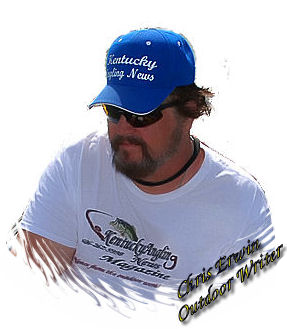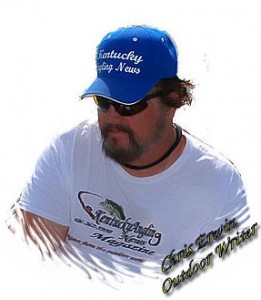
By Chris Erwin
[dc]W[/dc]hile I have been to my little camp on the banks of the Licking River a few times this spring, I was unable to take my boat until this past weekend, so I wanted to take you along as I try to figure out the first fishing pattern of the season.
The weather man said the rain wasn’t supposed to begin until Sunday evening, so I was excited to get my weekend started. I didn’t get on the water until Saturday at about 10 a.m. and the first thing I noticed was the wind. It was going to be a factor. The river was stained but not muddy.
I also have the advantage of having some really good anglers report to me on fishing around the state every week, and with their help we all know a little more about these lakes before we actually get on the water.
I had a theory that the crappie were nesting, and I felt that some bass and muskie were staging and taking swipes at these fish. To explore this theory, I rigged a 12-foot crappie rod using six-pound line and a 32 oz jig dressed with a two inch white curly tailed grub. I then looked for lay-down trees that extended into deeper water.
Using the jig, I dropped it near the end of the lay-down trees. In seconds, I was catching crappie. Once I found them I backed off the spot and started throwing baits. I used jerkbaits, crankbaits, and lipless crankbaits. I had very little success using these plugs. 
However, I did notice something. I started catching bass on the crappie jig if I worked it out past the down tree and got the jig into 10 feet of water. The bass were small, but they were there.
I next decided to rig a swimming jig, something that you would put on an A-rig. The one I used was about four inches long. It only took a few minutes to start catching fish. The bass were larger but nothing to brag about. The largest bass was about 14 inches, but I did put about 15 fish in the boat. The theory was sound but the fish were small.
My plan was to make some adjustments on Sunday and move my efforts to known migration routes that were near some of these crappie nesting sites. I felt I had a good chance to have a better day on Sunday.
Late Saturday evening after sunset, the rain began. I was sure the rain would stop by morning but my hopes soon began to fade as I stood looking out over the water on Sunday.
The rain was pelting down like Noah himself was standing there ready to launch his craft. Sunday’s hope was soon laid to rest as the rains continued to blister the ground and my theory ended half done.
On a different note, I also wanted to share with you some news from the Kentucky Department of Fish and Wildlife concerning Greenbo Lake fish sampling results. These are notes shared with us by Fred R. Howes, District Biologist Northeastern Fishery District Kentucky Fish and Wildlife.
“Our CPUE (the number of fish caught in one hour of electrofishing) was slightly below the average, 181, at 176 but this is not alarming at all. All in all, the numbers are about the same as in past years with fish captured representing all lengths up to 21 inches. That is pretty normal, sometimes we capture a 22 or 23 incher. When I ran a PSD or proportional stock density, which gives me an indication of whether or not the population is in balance, it came out to be 51. That is fairly good. The last several years it’s been just above 40. The range for a balanced poppulation is 40-70.
In general, over the past, the bass numbers at Greenbo are consistently low and most probably due to the lack of fertility. An indication of the low fertility is evident by the water clarity, secchi reading from 13 to 20 feet deep at times, which pretty much has averaged 15 feet over the years. The only way to attempt to raise the fertility is to fertilize and we will not do this in lakes where rainbows are stocked.
This lake consistently produces some real nice bass and what really helps is the stocking of trout. Often times we see 14 inch bass with an 8 inch trout stuffed in it. Another interesting thing about this lake is that it only has a 12-inch minimum size limit, which in most lakes with this size limit our findings show bass disappearing once they reach 12-inches. Bass at Greenbo are hard to catch and I think this helps this population out to some degree.
In a nut shell, the bass continue to hold their own and the bluegills are steadily showing progress.



Be the first to comment